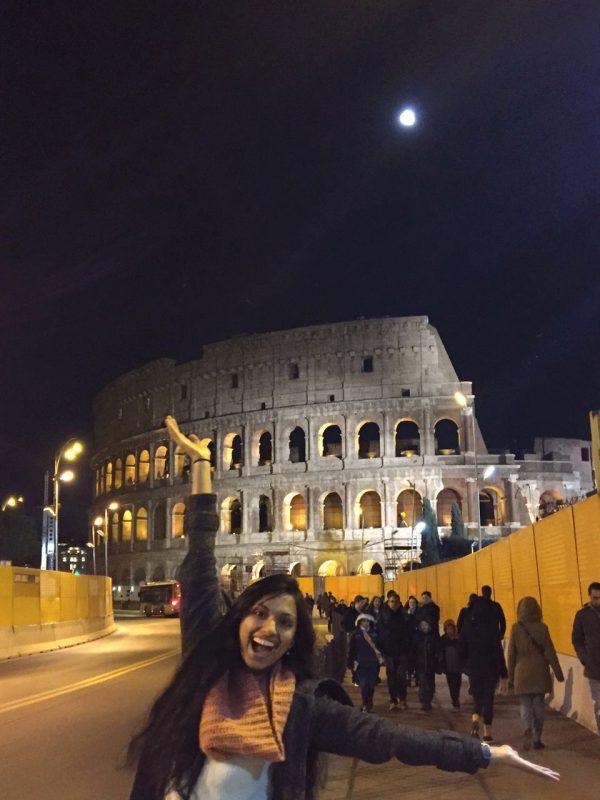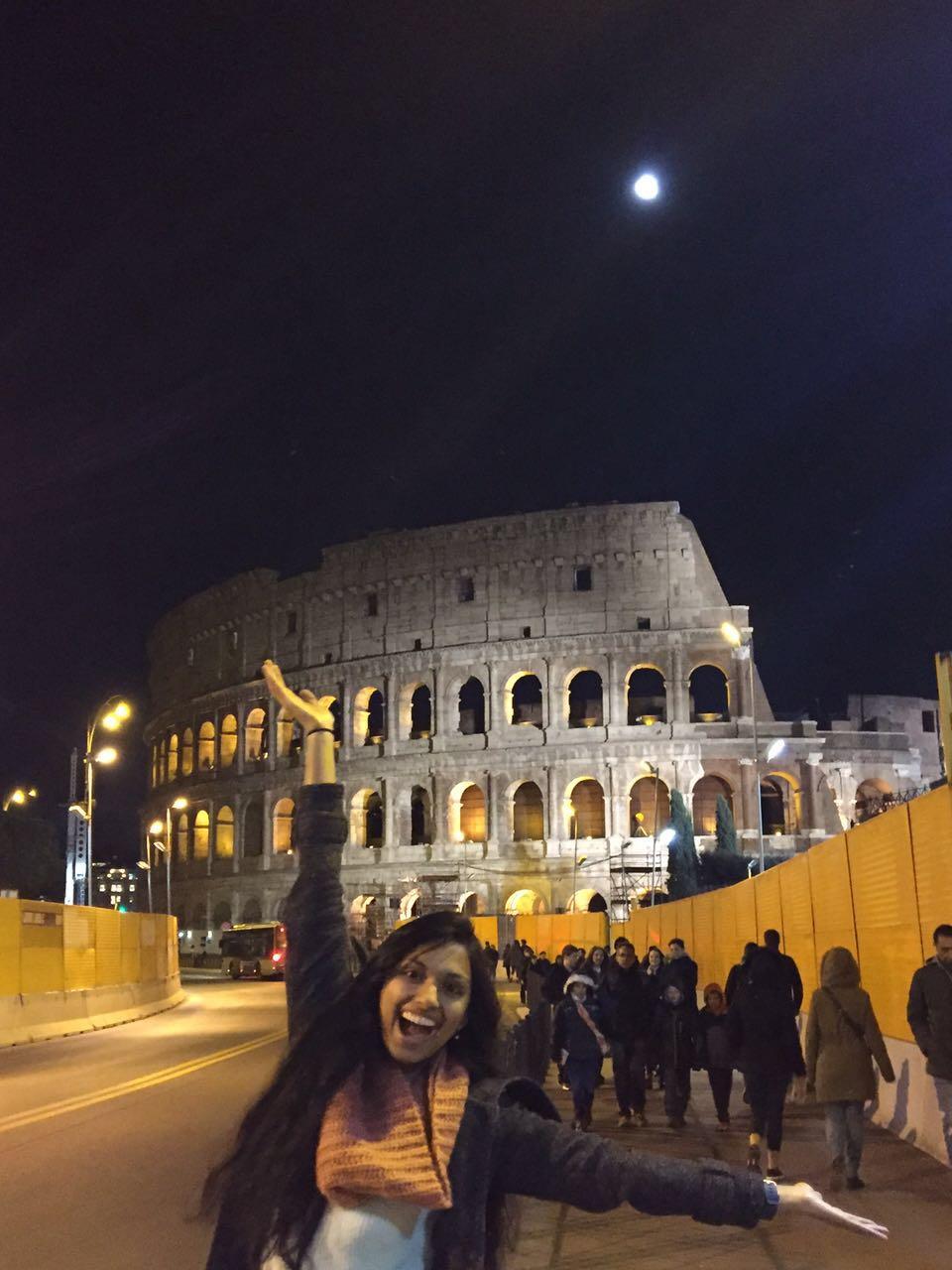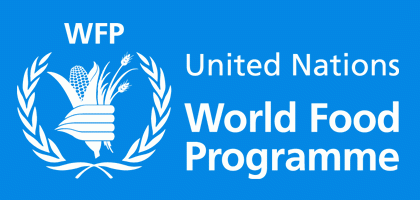You never know where a Capstone Design project will take you. 2014 ISyE grad Sangeeta Gadepalli explains how hers helped her land a contract with the UN World Food Programme in Rome.

The Capstone Design Expo is a right of passage for most engineering graduates, and while some projects turn into viable prototypes or business plans many students expect to finish their involvement with their projects when they leave Georgia Tech. That wasn't quite the case for industrial and systems engineering major Sangeeta Gadepalli and her team, who made such an impression on their project sponsor that they heard back from them almost two years later.
1. Where are you from and why did you choose Georgia Tech?
I am from Atlanta. I have lived here for about 10 years and before that I lived in India. I chose Georgia Tech because it had one of the top-ranked engineering programs in the world and they also had a very reputable Co-op program, both of which were very important to my academic career.
2. Why did you choose ISyE as a major and what did you enjoy the most about it?
I chose ISyE because I have always been drawn towards management science, but I also wanted an engineering degree and I believe ISyE does a fantastic job of combining the two. I enjoyed every aspect of ISyE because what you learn is very practical and can be implemented in a day-to-day situation. My favorite classes that I took include Manufacturing & Warehousing, Stochastics, Logistics, and Supply Chain Economics. I must say, all the ISyE professors are fantastic and do a great job not just providing classroom education but also discussing real-life scenarios and enriching students with their experiences and knowledge. All of the ISyE professors are very accomplished and distinguished and learning from their experiences further enhances the educational experience.
3. What was your Capstone experience like? What kind of research did you do for the project and what kind of contacts did you make?
My Capstone project was a roller coaster ride. We had our ups and downs because as any Techie would know, Senior Design is a strenuous course. My research was more in terms of what kind of company would we want to work with and what kind of problems do we want to tackle. The summer before my senior year, I started to ask classmates if they were interested in being in a team or if they had a team. Luckily, everything fell right into place and I had a wonderful team (Maria Ayers, Ashfaque Kachwala, Tahsin Munir, Cane Punma, Gabriel Rodriguez, and Yuvraj Singh). We all got along great and we all had something to contribute. Later in the fall semester, we started to make an Excel sheet of companies that we wanted to work with and we cold called and emailed anyone and everyone we could. Among those contacts was WFP (World Food Programme). We sat down with our main contact at WFP and discussed the project and how we would be helping. After a few days, we got an email saying that they would like to work with us.
We spent the rest of the semester working with our senior design advisor, Dr. Ozlem Ergun and a PhD student who worked with WFP, Mallory Soldner. We devised an algorithm that would make supply chain decisions simultaneously increasing visibility across the supply chain. In other words, this tool would look at all possible combinations of commodities, suppliers, and routing options together. This approach would increase visibility among various departments thus producing an optimal food basket. With this tool, we estimated WFP to potentially save 12.91% of their total supply chain costs which translates to about $34M.
4.What have you been doing since graduation?
After graduation, I took up a full-time with a technology consulting firm as a business analyst. I worked with various clients in the IT industry and my roles have mostly been centered around project management. I worked on resource budgeting and forecasting, time reporting, and managing project tasks and deadlines for Fortune 500 companies.
5. How did your opportunity in Rome come about?
Not long ago, our team got an email from our contact at WFP. He shared the news of how our algorithm was doing and what has changed since we have handed it over. He also mentioned that they are planning to expand some operations and as such would like to expand their Supply Chain Development team. So if any of us were interested, we would have to email back with our resumes and they would call us for an interview.
I dropped a note with my resume and heard back from the client fairly quickly. Over a span of a two weeks, all the formalities were completed and I was offered a contract-based full-time position as a Supply Chain Consultant for 6 months!
6. What are your duties be in Rome? Is it a contract position or do you see yourself staying there for a while?
I just finished my first week at WFP and it was great! The team is filled with brilliant, friendly, and passionate individuals who genuinely enjoy the work they do. We have everyone from new graduates, to PhDs, to full-timers who have been here for a very long time.
Unfortunately, I cannot give out too many details about my job but I can give a brief overview. I will be working alongside my supervisor streamlining the tool in order to make it available to all end users by connecting the tool to a web app. This web app will automate data retrieval, therefore minimizing any manual tasks. It is a contract position for 6 months with a possibility of extension.
7. Why is food distribution a problem and how is the UN tackling it?
Imagine providing food to a household of four. You buy groceries and you cook the food that the family will eat. But imagine if it were a household of 40 instead of four. At this point, planning becomes essential. Food distribution on a global-scale is a difficult task to accomplish when considering population, nutrition, and preferences. For example, we cannot provide the same composition of food to a child of age six and a pregnant woman. Their nutrition requirements are vastly different. But this is just an example of a demographic difference. Now imagine, two separate regions such as India and Syria. India is a country where majority of the population are Hindus and they do not eat beef. Syria on the other hand does not have this constraint. So as you can see, these small constraints can add up very quickly and that leads to a problem on supplying the optimal food basket which is also nutritious and edible.
WFP has been doing a great job so far reaching out to over 80 million people in 75 countries each year. It is the largest humanitarian organization fighting hunger worldwide (wfp.org/about). WFP partners with local and regional governments, other UN agencies, NGOs, and the private sector to help communities meet their nutritional necessities. They assess the demographics, plan food baskets, source commodities, and deliver all of it to the beneficiaries. Because these are large-scale operations, there may be some complexities and discrepancies but the general process is the same.
8. How did your time at Tech prepare you for this job?
Time and time again, we've all heard about Tech's level of difficulty. At Tech, I have noticed that students are always working and not just on academics. Georgia Tech instills an attitude of persistence and resourcefulness, both of which have prepared me well for the working world. The quality of education we receive at this institution is of course world-class, but the character it builds is invaluable. My previous experience with WFP through Capstone has been very advantageous since I am familiar with inner workings and processes at WFP. But more than academics, I believe Tech has prepared me well when it comes to using all the resources at my disposal and it has taught me time management which will be very useful in this role since it is short term.
NOTE: The 2016 Spring Capstone Design Expo will take place on April 26 in McCamish Pavilion. The event is free and open to the public with doors opening at 4:30 pm.

